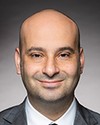Thank you, Mr. Chair.
I am pleased to be here today to speak about how we are managing the Canada-United States Border.
Canada shares the longest non-militarized land border in the world with the United States. In many ways, the border defines the relationship between our two countries. I think all of us here can agree that, over our history, our relationship has brought real benefits.
Last year, nearly $3.6 billion worth of trade and about 400,000 people crossed the Canada-U.S. border—every single day.
It also brings challenges. We are constantly having to balance the movement of legitimate trade and travel with measures to keep our border secure. Both countries are dealing with irregular migration, human smuggling, and illegal drug and firearms trafficking. All these are compounded by the involvement of transnational organized criminal groups.
To counter these threats, we have a long history of working closely with the United States each and every day. I recently met with my U.S. counterpart, the Secretary of Homeland Security, Kristi Noem, in the U.K. Canada's Attorney General and I met with U.S. Attorney General Pam Bondi over the summer. We have been in constant engagement with other officials, including U.S. border czar Tom Homan and the U.S. Ambassador to Canada, along with many of our officials here.
Public Safety Canada, the CBSA and the RCMP, along with the fentanyl czar, have regular daily interactions with their counterparts in the U.S. This week, the fentanyl czar, the RCMP commissioner and the president of the CBSA travelled to Washington, D.C. to meet with the head of the Drug Enforcement Administration, Terrance Cole, and with the commissioner of U.S. Customs and Border Protection, Rodney Scott. These discussions build on the already strong intelligence and information-sharing work we do with the U.S., and they underscore the importance of this collaboration.
However, there is always more that we can do. That is why the Government of Canada is taking a number of steps to improve the security of our borders.
It starts with our border plan, which is already delivering results. We've increased the resources along the border and are investing in new technologies to improve surveillance and detection.
Southbound irregular migration between Canada and the United States has dropped 99% since last year.
Together with the United States, we launched a North American joint strike force to target transnational organized crime, precursor chemicals and illegal substances, including fentanyl. Here at home, we established a joint operational intelligence cell to strengthen collaboration among agencies and advance investigations into the illicit cross-border movement of fentanyl. Those efforts also reinforce our work with our American counterparts.
We are also training and deploying new border detector dog teams who can sniff out fentanyl. While less than 1% of illegal fentanyl seized in the U.S. is linked to Canada, we know how important it is to get this drug off our streets, whether in Canada or the United States. A safe and secure flow of goods and people across the Canada-U.S. border is critical to North America's economy.
That is why we continue to look for ways to make it easier and faster to cross the border without compromising the integrity of our immigration system. Under the border plan, we have strengthened visa screening and integrity measures. It also provides over $55 million to CBSA to increase the agency's removals capacity. We're seeing results. The agency removed over 18,000 inadmissible people in 2024-25, the highest in a decade and an increase from approximately 16,000 the year before.
Finally, Mr. Chair, as committee members know, our government has introduced Bill C-12, the strengthening Canada's immigration system and borders act. This bill supports efforts to secure our border by tackling organized crime and money laundering and enhancing the integrity and fairness of our immigration system.
This bill provides the authorities needed to take decisive action and protect Canadians.
The measures in the bill also advance shared Canada-U.S. priorities, such as disrupting the cross-border flow of illicit drugs, strengthening law enforcement co-operation and improving information sharing. Given the importance of Bill C-12 to protecting our borders, I urge members of this committee to support its swift passage.
Thank you, Mr. Chair. I look forward to the questions.




